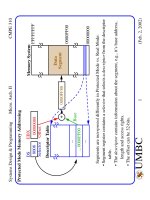Thiết kế và lập trình hệ thống - Chương5
Bạn đang xem bản rút gọn của tài liệu. Xem và tải ngay bản đầy đủ của tài liệu tại đây (275.31 KB, 9 trang )
Systems Design & Programming Micro. Arch IV CMPE 310
1 (Feb 3, 2002)
UMBC
U M B C
U
N
I
V
E
R
S
I
T
Y
O
F
M
A
R
Y
L
A
N
D
B
A
L
T
I
M
O
R
E
C
O
U
N
T
Y
1
9
6
6
Segmentation and the User Application
The application programmer loads segment register values as before in Real Mode,
but the values that he/she puts in them are very different.
Since knowledge of the GDT and LDT is not generally available at compile
time, the programmer must use symbolic names.
The loader is responsible for resolving the actual values at run time.
In general, the segment values are 16-bit tags for the address spaces of the program.
Instructions such as LDS (load DS), LAR (load access rights), LSL (load seg-
ment limit), VERR (verify for read) are available to retrieve descriptor
attributes, if the process is privileged enough.
Whenever a segment register is changed, sanity checks are performed before the
descriptor is cached.
• The index is checked against the limit.
• Other checks are made depending on the segment type, e.g., data segments, DS
cannot be loaded with pointers to execute-only descriptors, ...
• The present flag is checked.
Otherwise, an exception is raised and nothing changes.
Systems Design & Programming Micro. Arch IV CMPE 310
2 (Feb 3, 2002)
UMBC
U M B C
U
N
I
V
E
R
S
I
T
Y
O
F
M
A
R
Y
L
A
N
D
B
A
L
T
I
M
O
R
E
C
O
U
N
T
Y
1
9
6
6
Privilege Levels
0: highest privilege, 3: lowest privilege
The privilege protection system plays a role for almost every instruction executed.
Protection mechanisms check if the process is privileged enough to:
• Execute certain instructions, e.g., those that modify the Interrupt flag, alter the seg-
mentation, or affect the protection mechanism require PL 0.
• Reference data other than its own. References to data at higher privilege levels is
not permitted.
• Transfer control to code other than its own. CALLs or JMPs to code with a differ-
ent privilege level (higher or lower) is not permitted.
Kernel (PL=0)
System services (PL=1)
OS extensions (PL=2)
Applications (PL=3)
Systems Design & Programming Micro. Arch IV CMPE 310
3 (Feb 3, 2002)
UMBC
U M B C
U
N
I
V
E
R
S
I
T
Y
O
F
M
A
R
Y
L
A
N
D
B
A
L
T
I
M
O
R
E
C
O
U
N
T
Y
1
9
6
6
Privilege Levels
Privilege levels are assigned to segments, as we have seen, using the DPL (Descriptor
Privilege Level) field (bits 45 and 46).
Define CPL as the Code Privilege Level of the process, which is the DPL
of its code segment!
Define RPL as the Requestor’s Privilege Level.
Privilege Level Definitions:
When data selectors are loaded, the corresponding data segment’s DPL is
compared to the larger of your CPL or the selector’s RPL.
Therefore, you can use RPL to weaken your current privilege level, if you want.
Segment Register, e.g. DS
CS
RPL
CPL
> of
Descriptor Table
EPL
DPL
check
Exception 13
if EPL > DPL
From code
segment descriptor
Systems Design & Programming Micro. Arch IV CMPE 310
4 (Feb 3, 2002)
UMBC
U M B C
U
N
I
V
E
R
S
I
T
Y
O
F
M
A
R
Y
L
A
N
D
B
A
L
T
I
M
O
R
E
C
O
U
N
T
Y
1
9
6
6
Privilege Levels
CPL is defined by the descriptors, so access to them must be restricted.
Privileged Instructions:
• Those that affect the segmentation and protection mechanisms (CPL=0 only).
For example, LGDT, LTR, HLT.
• Those that alter the Interrupt flag (CPL <= IOPL field in EFLAGS).
For example, CLI, STI (Note: only DPL 0 code can modify the IOPL
fields.)
• Those that perform peripheral I/O (CPL <= IOPL field in EFLAGS).
For example, IN, OUT.
Privileged Data References:
Two checks are made in this case:
• Trying to load the DS, ES, FS or GS register with a selector whose DPL is >
the DPL of the code segment descriptor generates a general protection fault.
• Trying to use a data descriptor that has the proper privilege level can also be
illegal, e.g. trying to write to a read-only segment.
For SS, the rules are even more restrictive.
Systems Design & Programming Micro. Arch IV CMPE 310
5 (Feb 3, 2002)
UMBC
U M B C
U
N
I
V
E
R
S
I
T
Y
O
F
M
A
R
Y
L
A
N
D
B
A
L
T
I
M
O
R
E
C
O
U
N
T
Y
1
9
6
6
Privilege Levels
Privileged Code References:
Transferring control to code in another segment is performed using the FAR
forms of JMP, CALL and RET.
These differ from intra-segment (NEAR) transfers in that they change both CS
and EIP.
The following checks are performed:
• The new selector must be a code segment (e.g. with execute attribute).
• CPL is set to the DPL (RPL is of no use here).
• The segment is present.
• The EIP is within the limits defined by the segment descriptor.
The RPL field is always set to the CPL of the process, independent of what was
actually loaded.
You can examine the RPL field of CS to determine your CPL.









